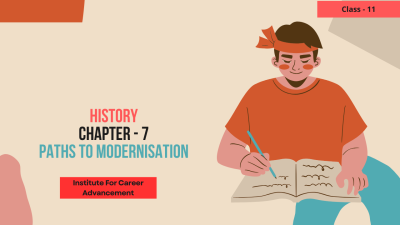Courses


 Compare
Compare
Paths to Modernization is a course that explores the various pathways that different societies have taken to achieve modernization. It examines the factors that contribute to modernization, such as economic development, technological advancements, political reforms, and social changes. Key topics covered in this course include: Westernization and Modernization: The role of Western influence in the modernization process of non-Western societies. Economic Development and Modernization: The relationship between economic growth, industrialization, and modernization. Technological Advancements and Modernization: The impact of technological innovations on societies and their modernization. Political Reforms and Modernization: The role of political institutions, governance, and democracy in modernization. Social Changes and Modernization: The ways in which social structures, values, and attitudes change as societies modernize. By studying Paths to Modernization, students gain a better understanding of the complex factors that shape the development of societies and the diverse paths that they can take towards modernity. This course also encourages critical thinking and analysis, as students examine the advantages and challenges associated with different modernization models. আধুনিকীকরণের পথ হল এমন একটি পথ যা আধুনিকীকরণ অর্জনের জন্য বিভিন্ন সমাজ যে বিভিন্ন পথ গ্রহণ করেছে তা অন্বেষণ করে। এটি অর্থনৈতিক উন্নয়ন, প্রযুক্তিগত অগ্রগতি, রাজনৈতিক সংস্কার এবং সামাজিক পরিবর্তনের মতো আধুনিকীকরণের ক্ষেত্রে অবদান রাখার কারণগুলি পরীক্ষা করে। এই কোর্সে অন্তর্ভুক্ত মূল বিষয়গুলির মধ্যে রয়েছেঃ পাশ্চাত্যায়ন ও আধুনিকীকরণঃ অ-পাশ্চাত্য সমাজের আধুনিকীকরণ প্রক্রিয়ায় পাশ্চাত্য প্রভাবের ভূমিকা। অর্থনৈতিক উন্নয়ন ও আধুনিকীকরণঃ অর্থনৈতিক প্রবৃদ্ধি, শিল্পায়ন ও আধুনিকীকরণের মধ্যে সম্পর্ক। প্রযুক্তিগত অগ্রগতি এবং আধুনিকীকরণঃ সমাজে প্রযুক্তিগত উদ্ভাবনের প্রভাব এবং তাদের আধুনিকীকরণ। রাজনৈতিক সংস্কার ও আধুনিকীকরণঃ আধুনিকায়নে রাজনৈতিক প্রতিষ্ঠান, শাসন ও গণতন্ত্রের ভূমিকা। সামাজিক পরিবর্তন এবং আধুনিকীকরণঃ সমাজের আধুনিকীকরণের সাথে সাথে সামাজিক কাঠামো, মূল্যবোধ এবং মনোভাবের পরিবর্তন হয়। আধুনিকীকরণের পথগুলি অধ্যয়নের মাধ্যমে, শিক্ষার্থীরা সমাজের বিকাশকে রূপদানকারী জটিল কারণগুলি এবং আধুনিকতার দিকে নিয়ে যেতে পারে এমন বৈচিত্র্যময় পথগুলি সম্পর্কে আরও ভাল ধারণা অর্জন করে। এই কোর্সটি সমালোচনামূলক চিন্তাভাবনা এবং বিশ্লেষণকেও উৎসাহিত করে, কারণ শিক্ষার্থীরা বিভিন্ন আধুনিকীকরণ মডেলের সাথে সম্পর্কিত সুবিধা এবং চ্যালেঞ্জগুলি পরীক্ষা করে।
0 Lessons
Hours

 Compare
Compare
Displacing Indigenous People is a course that examines the historical and ongoing process of forcibly removing indigenous peoples from their ancestral lands. It explores the complex factors that contribute to displacement, including colonialism, resource extraction, and government policies. Key topics covered in this course include: Colonialism and Indigenous Land Loss: The role of colonialism in displacing indigenous peoples and seizing their lands. Resource Extraction and Indigenous Rights: The conflict between resource extraction industries and indigenous land claims. Government Policies and Indigenous Displacement: The impact of government policies, such as land reform and resettlement programs, on indigenous communities. Indigenous Resistance and Activism: The strategies and tactics used by indigenous peoples to resist displacement and protect their rights. The Consequences of Displacement: The social, economic, and cultural impacts of displacement on indigenous communities. By studying the displacement of indigenous peoples, students gain a better understanding of the historical and ongoing injustices faced by marginalized groups. This course also encourages critical thinking and empathy, as students explore the complex issues surrounding land rights, cultural preservation, and social justice. আদিবাসীদের স্থানচ্যুত করা এমন একটি কোর্স যা আদিবাসীদের তাদের পৈতৃক জমি থেকে জোরপূর্বক অপসারণের ঐতিহাসিক এবং চলমান প্রক্রিয়া পরীক্ষা করে। এটি উপনিবেশবাদ, সম্পদ উত্তোলন এবং সরকারী নীতি সহ স্থানচ্যুতিতে অবদান রাখে এমন জটিল কারণগুলি অন্বেষণ করে। এই কোর্সে অন্তর্ভুক্ত মূল বিষয়গুলির মধ্যে রয়েছেঃ উপনিবেশবাদ এবং আদিবাসী ভূমি ক্ষতিঃ আদিবাসীদের স্থানচ্যুত করা এবং তাদের জমি দখল করার ক্ষেত্রে উপনিবেশবাদের ভূমিকা। সম্পদ উত্তোলন এবং আদিবাসী অধিকারঃ সম্পদ উত্তোলন শিল্প এবং আদিবাসী ভূমি দাবির মধ্যে দ্বন্দ্ব। সরকারী নীতি এবং আদিবাসী স্থানচ্যুতিঃ আদিবাসী সম্প্রদায়ের উপর ভূমি সংস্কার এবং পুনর্বাসন কর্মসূচির মতো সরকারী নীতির প্রভাব। আদিবাসী প্রতিরোধ ও সক্রিয়তাঃ স্থানচ্যুতি প্রতিরোধ এবং তাদের অধিকার রক্ষার জন্য আদিবাসীদের দ্বারা ব্যবহৃত কৌশল ও কৌশল। স্থানচ্যুতির ফলাফলঃ আদিবাসী সম্প্রদায়ের উপর স্থানচ্যুতির সামাজিক, অর্থনৈতিক ও সাংস্কৃতিক প্রভাব। আদিবাসীদের স্থানচ্যুতি অধ্যয়নের মাধ্যমে, শিক্ষার্থীরা প্রান্তিক গোষ্ঠীগুলির সম্মুখীন হওয়া ঐতিহাসিক এবং চলমান অবিচার সম্পর্কে আরও ভাল ধারণা অর্জন করে। এই কোর্সটি সমালোচনামূলক চিন্তাভাবনা এবং সহানুভূতিকেও উৎসাহিত করে, কারণ শিক্ষার্থীরা ভূমি অধিকার, সাংস্কৃতিক সংরক্ষণ এবং সামাজিক ন্যায়বিচার সম্পর্কিত জটিল বিষয়গুলি অন্বেষণ করে।
0 Lessons
Hours

 Compare
Compare
Changing Cultural Traditions is a course that explores how cultures evolve over time. It delves into the factors that influence cultural change, such as globalization, technology, migration, and social movements. Key topics covered in this course include: Globalization and Cultural Exchange: How globalization has led to the spread of ideas, goods, and cultures across borders. Technology and Cultural Change: The impact of technological advancements on cultural practices, communication, and values. Migration and Cultural Hybridity: How migration has led to the blending of different cultures and the creation of new cultural identities. Social Movements and Cultural Change: The role of social movements in challenging existing cultural norms and values. Cultural Preservation and Adaptation: The efforts to preserve traditional cultures in the face of change, and how cultures adapt to new circumstances. By studying changing cultural traditions, students gain a better understanding of the interconnectedness of cultures and the forces that shape our world today. সাংস্কৃতিক ঐতিহ্যের পরিবর্তন এমন একটি কোর্স যা সময়ের সাথে সাথে সংস্কৃতির বিবর্তন কীভাবে হয় তা অনুসন্ধান করে। এটি বিশ্বায়ন, প্রযুক্তি, অভিবাসন এবং সামাজিক আন্দোলনের মতো সাংস্কৃতিক পরিবর্তনকে প্রভাবিত করে এমন কারণগুলি অনুসন্ধান করে। এই কোর্সে অন্তর্ভুক্ত মূল বিষয়গুলির মধ্যে রয়েছেঃ বিশ্বায়ন এবং সাংস্কৃতিক বিনিময়ঃ বিশ্বায়ন কীভাবে সীমান্ত পেরিয়ে ধারণা, পণ্য এবং সংস্কৃতির বিস্তার ঘটিয়েছে। প্রযুক্তি ও সাংস্কৃতিক পরিবর্তনঃ সাংস্কৃতিক অনুশীলন, যোগাযোগ এবং মূল্যবোধের উপর প্রযুক্তিগত অগ্রগতির প্রভাব। অভিবাসন ও সাংস্কৃতিক সংকরতাঃ অভিবাসন কীভাবে বিভিন্ন সংস্কৃতির সংমিশ্রণ এবং নতুন সাংস্কৃতিক পরিচয় সৃষ্টির দিকে পরিচালিত করেছে। সামাজিক আন্দোলন ও সাংস্কৃতিক পরিবর্তনঃ বিদ্যমান সাংস্কৃতিক নিয়ম ও মূল্যবোধকে চ্যালেঞ্জ করার ক্ষেত্রে সামাজিক আন্দোলনের ভূমিকা। সাংস্কৃতিক সংরক্ষণ ও অভিযোজনঃ পরিবর্তনের মুখে ঐতিহ্যবাহী সংস্কৃতি সংরক্ষণের প্রচেষ্টা এবং কীভাবে সংস্কৃতিগুলি নতুন পরিস্থিতির সাথে খাপ খাইয়ে নেয়। পরিবর্তিত সাংস্কৃতিক ঐতিহ্য অধ্যয়নের মাধ্যমে শিক্ষার্থীরা সংস্কৃতির আন্তঃসংযোগ এবং আজকের বিশ্বকে রূপদানকারী শক্তি সম্পর্কে আরও ভাল ধারণা অর্জন করে।
0 Lessons
Hours

 Compare
Compare
The Three Orders was a social hierarchy system that dominated medieval European society. It divided society into three distinct classes or "orders": Clergy: This order consisted of religious figures, such as priests, monks, and nuns. They were considered the spiritual leaders of society and were often exempt from many of the same laws and obligations as the other two orders. Nobility: This order was composed of the aristocracy, including kings, dukes, barons, and knights. They were the political and military elite, owning vast tracts of land and holding positions of power. Peasantry: This order made up the majority of the population and consisted of peasants, farmers, and laborers. They worked the land, providing food and labor for the other two orders. The Three Orders system was a rigid and hierarchical structure that helped to maintain social order and stability in medieval Europe. However, it also reinforced inequality and limited opportunities for social mobility. Over time, the system began to break down as economic changes and social unrest led to the rise of new classes and the decline of the traditional feudal system. থ্রি অর্ডার ছিল একটি সামাজিক শ্রেণিবিন্যাস ব্যবস্থা যা মধ্যযুগীয় ইউরোপীয় সমাজে আধিপত্য বিস্তার করেছিল। এটি সমাজকে তিনটি স্বতন্ত্র শ্রেণী বা "অর্ডারে" বিভক্ত করেছিলঃ পুরোহিতঃ এই আদেশে পুরোহিত, সন্ন্যাসী এবং সন্ন্যাসিনীদের মতো ধর্মীয় ব্যক্তিত্বরা ছিলেন। তাদের সমাজের আধ্যাত্মিক নেতা হিসাবে বিবেচনা করা হত এবং প্রায়শই অন্য দুটি আদেশের মতো একই আইন ও বাধ্যবাধকতা থেকে অব্যাহতি দেওয়া হত। অভিজাতত্বঃ এই ক্রমটি রাজা, ডিউক, ব্যারন এবং নাইট সহ অভিজাতদের নিয়ে গঠিত ছিল। তারা ছিল রাজনৈতিক ও সামরিক অভিজাত, বিশাল জমির মালিক এবং ক্ষমতার পদে অধিষ্ঠিত। কৃষকঃ এই আদেশটি জনসংখ্যার সংখ্যাগরিষ্ঠ অংশ নিয়ে গঠিত এবং কৃষক, কৃষক এবং শ্রমিকদের নিয়ে গঠিত। তারা জমিতে কাজ করত, অন্য দুটি আদেশের জন্য খাদ্য ও শ্রম সরবরাহ করত। থ্রি অর্ডার সিস্টেম ছিল একটি কঠোর এবং শ্রেণিবদ্ধ কাঠামো যা মধ্যযুগীয় ইউরোপে সামাজিক শৃঙ্খলা এবং স্থিতিশীলতা বজায় রাখতে সহায়তা করেছিল। তবে, এটি অসমতা এবং সামাজিক গতিশীলতার সীমিত সুযোগকেও শক্তিশালী করেছে। সময়ের সাথে সাথে, অর্থনৈতিক পরিবর্তন এবং সামাজিক অস্থিরতা নতুন শ্রেণীর উত্থান এবং ঐতিহ্যবাহী সামন্ততান্ত্রিক ব্যবস্থার পতনের দিকে পরিচালিত করায় ব্যবস্থাটি ভেঙে পড়তে শুরু করে।
0 Lessons
Hours

 Compare
Compare
Nomadic empires were established by groups of people who primarily lived by herding animals and moving from place to place in search of pasture. These nomadic groups, often referred to as steppe nomads, were skilled horsemen and archers, and their empires were characterized by their vast territories and rapid conquests. Key characteristics of nomadic empires: Pastoral lifestyle: Nomads relied primarily on livestock such as horses, sheep, and cattle for sustenance. Mobility: They moved regularly to find fresh grazing land and water. Military prowess: Nomads were known for their exceptional horsemanship and archery skills, making them formidable warriors. Centralized rule: Despite their nomadic lifestyle, nomadic empires often had strong centralized governments, led by powerful khans or emperors. Cultural exchange: Through their conquests and trade, nomadic empires played a significant role in cultural exchange and diffusion. Famous examples of nomadic empires include: The Mongol Empire: Led by Genghis Khan, the Mongols conquered a vast territory spanning from Eastern Europe to China. The Huns: A nomadic confederation that invaded Western Europe in the 5th century AD. The Turks: A nomadic people who established various empires, including the Ottoman and Seljuk empires. যাযাবর সাম্রাজ্যগুলি এমন একদল লোকের দ্বারা প্রতিষ্ঠিত হয়েছিল যারা প্রাথমিকভাবে পশু পালন করে এবং চারণভূমির সন্ধানে এক জায়গা থেকে অন্য জায়গায় স্থানান্তরিত হয়েছিল। এই যাযাবর গোষ্ঠীগুলি, প্রায়শই স্তেপ যাযাবর হিসাবে উল্লেখ করা হয়, দক্ষ অশ্বারোহী এবং তীরন্দাজ ছিল এবং তাদের সাম্রাজ্যগুলি তাদের বিশাল অঞ্চল এবং দ্রুত বিজয় দ্বারা চিহ্নিত করা হত। যাযাবর সাম্রাজ্যের মূল বৈশিষ্ট্যগুলিঃ পশুপালক জীবনধারাঃ যাযাবররা জীবিকার জন্য মূলত ঘোড়া, ভেড়া এবং গবাদি পশুর উপর নির্ভর করত। চলাচলঃ তাজা চারণভূমি ও জলের সন্ধানে তারা নিয়মিত চলাচল করত। সামরিক দক্ষতাঃ যাযাবররা তাদের ব্যতিক্রমী অশ্বারোহণ এবং তীরন্দাজি দক্ষতার জন্য পরিচিত ছিল, যা তাদের দুর্ধর্ষ যোদ্ধা করে তুলেছিল। কেন্দ্রীভূত শাসনঃ তাদের যাযাবর জীবনধারা সত্ত্বেও, যাযাবর সাম্রাজ্যগুলিতে প্রায়শই শক্তিশালী খান বা সম্রাটদের নেতৃত্বে শক্তিশালী কেন্দ্রীভূত সরকার ছিল। সাংস্কৃতিক বিনিময়ঃ তাদের বিজয় এবং বাণিজ্যের মাধ্যমে, যাযাবর সাম্রাজ্যগুলি সাংস্কৃতিক বিনিময় এবং বিস্তারের ক্ষেত্রে গুরুত্বপূর্ণ ভূমিকা পালন করেছিল। যাযাবর সাম্রাজ্যের বিখ্যাত উদাহরণগুলির মধ্যে রয়েছেঃ মঙ্গোল সাম্রাজ্যঃ চেঙ্গিস খানের নেতৃত্বে মঙ্গোলরা পূর্ব ইউরোপ থেকে চীন পর্যন্ত বিস্তৃত একটি বিশাল অঞ্চল জয় করে। হুনঃ একটি যাযাবর সংঘ যা 5ম শতাব্দীতে পশ্চিম ইউরোপ আক্রমণ করেছিল। তুর্কিরাঃ একটি যাযাবর মানুষ যারা অটোমান এবং সেলজুক সাম্রাজ্য সহ বিভিন্ন সাম্রাজ্য প্রতিষ্ঠা করেছিল।
0 Lessons
Hours

 Compare
Compare
An Empire Across Three Continents is a chapter in Class 11 History syllabus. It focuses on the Persian Empire, one of the largest and most influential empires of the ancient world. Key topics covered in this chapter might include: The rise and expansion of the Persian Empire: The Achaemenid dynasty and its conquests across Asia Minor, Mesopotamia, Egypt, and parts of India. The administration and governance of the Persian Empire: The satrap system, the Royal Road, and the standardization of currency and weights. The Persian Empire's cultural and religious influences: The Zoroastrian religion, Persian art, and architecture. The Persian Empire's interactions with other civilizations: Its relationship with Greece, India, and China. The fall of the Persian Empire: The conquest by Alexander the Great. This chapter aims to provide students with an understanding of the Persian Empire's significance in world history and its impact on the regions it ruled. অ্যান এম্পায়ার অ্যাক্রস থ্রি কন্টিনেন্টস হল একাদশ শ্রেণির ইতিহাস পাঠ্যক্রমের একটি অধ্যায়। এটি প্রাচীন বিশ্বের অন্যতম বৃহত্তম এবং প্রভাবশালী সাম্রাজ্য পারস্য সাম্রাজ্যের উপর দৃষ্টি নিবদ্ধ করে। এই অধ্যায়ে অন্তর্ভুক্ত মূল বিষয়গুলির মধ্যে অন্তর্ভুক্ত থাকতে পারেঃ পারস্য সাম্রাজ্যের উত্থান ও বিস্তারঃ আচেমেনিড রাজবংশ এবং এশিয়া মাইনর, মেসোপটেমিয়া, মিশর এবং ভারতের কিছু অংশ জুড়ে এর বিজয়। পারস্য সাম্রাজ্যের প্রশাসন ও শাসনঃ সত্রপ ব্যবস্থা, রয়েল রোড এবং মুদ্রা ও ওজনের প্রমিতকরণ। পারস্য সাম্রাজ্যের সাংস্কৃতিক ও ধর্মীয় প্রভাবঃ জরাথুস্ট্র ধর্ম, পারস্য শিল্প ও স্থাপত্য। অন্যান্য সভ্যতার সাথে পারস্য সাম্রাজ্যের মিথস্ক্রিয়াঃ গ্রীস, ভারত এবং চীনের সাথে এর সম্পর্ক। পারস্য সাম্রাজ্যের পতনঃ আলেকজান্ডার দ্য গ্রেট দ্বারা বিজয়। এই অধ্যায়ের লক্ষ্য হল শিক্ষার্থীদের বিশ্ব ইতিহাসে পারস্য সাম্রাজ্যের তাৎপর্য এবং এটি শাসিত অঞ্চলগুলিতে এর প্রভাব সম্পর্কে ধারণা প্রদান করা।
1 Lessons
Hours

 Compare
Compare
Writing and City Life is a chapter in Class 11 History syllabus. It focuses on the development of writing and its impact on early civilizations, particularly those centered around cities. Key topics covered in this chapter might include: The emergence of writing systems: Early forms of writing, such as cuneiform, hieroglyphics, and the Indus Valley script. The role of cities in the development of writing: How urban centers facilitated the exchange of ideas and information, leading to the creation and spread of writing systems. The impact of writing on society: How writing transformed communication, record-keeping, and the organization of complex societies. Examples of early civilizations with developed writing systems: The Mesopotamian, Egyptian, and Indus Valley civilizations. This chapter aims to provide students with an understanding of the significance of writing in human history and its connection to the rise and development of early civilizations. একাদশ শ্রেণির ইতিহাস পাঠ্যক্রমের একটি অধ্যায় হল রাইটিং অ্যান্ড সিটি লাইফ। এটি লেখার বিকাশ এবং প্রাথমিক সভ্যতার উপর এর প্রভাবের উপর দৃষ্টি নিবদ্ধ করে, বিশেষ করে শহরকে কেন্দ্র করে। এই অধ্যায়ে অন্তর্ভুক্ত মূল বিষয়গুলির মধ্যে অন্তর্ভুক্ত থাকতে পারেঃ লিখন পদ্ধতির উদ্ভবঃ লেখার প্রাথমিক রূপ, যেমন কিউনিফর্ম, হায়ারোগ্লিফিক এবং সিন্ধু উপত্যকা লিপি। লেখার বিকাশে শহরগুলির ভূমিকাঃ শহুরে কেন্দ্রগুলি কীভাবে ধারণা এবং তথ্যের বিনিময়কে সহজতর করেছিল, যার ফলে লিখন পদ্ধতি তৈরি এবং ছড়িয়ে পড়ে। সমাজে লেখার প্রভাবঃ কীভাবে লেখা যোগাযোগ, রেকর্ড রাখা এবং জটিল সমাজের সংগঠনকে রূপান্তরিত করে। উন্নত লিখন পদ্ধতি সহ প্রাথমিক সভ্যতার উদাহরণঃ মেসোপটেমিয়ান, মিশরীয় এবং সিন্ধু সভ্যতাগুলি। এই অধ্যায়ের লক্ষ্য হল শিক্ষার্থীদের মানব ইতিহাসে লেখার তাৎপর্য এবং প্রাথমিক সভ্যতার উত্থান ও বিকাশের সাথে এর সংযোগ সম্পর্কে ধারণা প্রদান করা।
0 Lessons
Hours

 Compare
Compare
The Gupta Empire was an ancient Indian empire which existed from the early 4th century CE to early 6th century CE. At its zenith, from approximately 319 to 467 CE, it covered much of the Indian subcontinent. গুপ্ত সাম্রাজ্য ছিল একটি প্রাচীন ভারতীয় সাম্রাজ্য যা খ্রিস্টীয় চতুর্থ শতাব্দীর শুরু থেকে খ্রিস্টীয় 6ষ্ঠ শতাব্দীর শুরু পর্যন্ত বিদ্যমান ছিল। তার শীর্ষে, আনুমানিক 319 থেকে 467 CE পর্যন্ত, এটি ভারতীয় উপমহাদেশের বেশিরভাগ অংশ জুড়ে ছিল।
4 Lessons
00:05:05 Hours